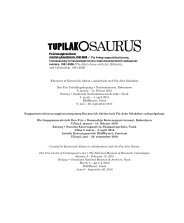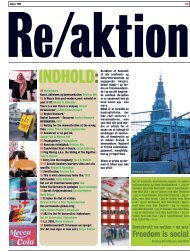tupilakosaurus - Print matters!
tupilakosaurus - Print matters!
tupilakosaurus - Print matters!
Create successful ePaper yourself
Turn your PDF publications into a flip-book with our unique Google optimized e-Paper software.
putuinnalimmik assilisat.<br />
1988-<br />
galluni assilisatoqqani isiginnaarpaa.<br />
Kamillaangarpasippoq, kisiannili arnat<br />
kalaallisuuisa kamisaat nasaliussimavaa!<br />
Assi killornerullugu aviisimi Sermitsiami<br />
(nr. 5, 1994) naqinneqarpoq, assillu allagartaa<br />
aallartippoq: “Kamik nasaliuguk,<br />
taava tamarmik takusinnaassavaat<br />
suminngaanneersuunersutit.” Tassa Arkep<br />
sunniutilimmik takutitsiniutaa Kalaallit<br />
Nunaanni aviisit annersaanni eqqumiitsuliornermik<br />
politikkip oqallisigineqarnerani<br />
eqqarsaatissiisumik akuliunnermigut,<br />
qisuariarfigisaami tassaavoq kalaallit<br />
eqqumiitsuliaasa itsarnitsanut akuliullugit<br />
saqqummersinneqartarnerat. Kalaallit<br />
eqqumiitsuliortut ataasiakkaat namminneerlutik<br />
kingoqqiffitik isummerfigisariaqarpaat.<br />
Kamimmik nasaqartoqarneq<br />
ajorpoq, Arkellumi isummernini takutissimasinnaagaluarpaa<br />
soorlu kalaallisoornermigut,<br />
kisianni taava taama uumisaarutaasimatiginavianngikkaluarpoq.<br />
Assiliivittaaq putuinnalik atorlugu<br />
Nuugaarsummi assilisami tassuma<br />
assiliarujussuanngortinnera tunuliaqutaraa<br />
assilissanut arlalinnut nammineq<br />
arnallu inuusuttut allat, namminermisulli<br />
Tunumi inunngorsimasut, Danmarkimilu<br />
maanna najugaqartut, ilagalugit. Assit<br />
ilagaat arnat pingasut qerattaffaarillutik<br />
annoqalutillu tallitik ammut tikkortillugit<br />
assilisissimasut. Soorluuna tigummiaminnit<br />
avissaarusuppasissut, ingerlaannarlu<br />
Kalaallit Nunaannik eqqaasitsillutik:<br />
qilaammik katuamillu, kiinarpammik<br />
inuusamillu kalaallisoortumik. Assi suliat<br />
sisamat De tre Gratier-imiittut (1993)<br />
ilagaat, kisiannili arnanik kusanartunik<br />
qitittunik takorluuisarnermit allaaqaaq.<br />
Arnat nutaaliat timiminnik ilusiliinerat<br />
kalaallillu sanaavinik tigummiariaasiisa<br />
ersersinngilaat siuaasat kulturiannut<br />
qamanngavik attaveqarneq, taamaattorli<br />
Arkep suliaasa tamarmik pisarnerattut<br />
qanoq paasineqarsinnaanerat ammavoq.<br />
Inge Kleivan<br />
Pia Arke.<br />
The camera obscura photographs. 1988-<br />
In 1988, the year after Pia Arke had<br />
started at the School of Painting at<br />
the Royal Danish Academy of Fine<br />
Arts in Copenhagen, she began to<br />
experiment with pinhole cameras.<br />
The special thing about the pinhole<br />
camera is that it does not have a<br />
lens, but instead a very small hole,<br />
which is covered until the picture is<br />
to be taken. When the light pours<br />
in through the hole, it hits a film on<br />
the opposite side of the camera.<br />
In 1990, after having tried out the<br />
technique in Denmark, Arke had her<br />
big pinhole camera sent by ship to<br />
Narsaq. Like some of the old users<br />
of the camera obscura technique,<br />
she chose to use a box that was large<br />
enough for her to be inside it. It<br />
was made of plywood and laths and<br />
had a floor area of 165 cm x 140 cm<br />
and a height of 170 cm. The light<br />
entered through a 1.43 mm hole bored<br />
through a thin metal plate on one<br />
wall, while the film on the opposite<br />
wall was a 6 ASA black-and-white<br />
lithfil 50 cm x 60 cm. From Narsaq<br />
she had the camera brought to Nuugaarsuk<br />
close to where she had lived<br />
for some years in her childhood. The<br />
house had been pulled down, but Arke<br />
had her camera set up so that it could<br />
catch the view that the family had<br />
once had: mountains, water and ice.<br />
The outcome was beautiful, slightly<br />
blurred landscape photos. When<br />
she sat inside the box, she could<br />
watch the picture forming, and it<br />
was also possible for her to shadow<br />
it with her body, so that less light<br />
fell on the film. The exposure time<br />
was from 15 min. and upwards,<br />
and because of the size of the film<br />
it had to be developed in a big tub,<br />
which made it difficult to control the<br />
process. Arke said later of her “mistakes”<br />
that the 25 years that had<br />
passed since then “were in a way<br />
registered in the picture” (Weekendavisen,<br />
April 29 – May 6, 1999).<br />
In 1993 Pia Arke went a step further<br />
by having one of her Greenland<br />
pinhole photos form part of new<br />
photographs containing a strong<br />
element of contrast. In one of them<br />
Arke herself is sitting with her back<br />
to the camera and looking at the<br />
old photo. She doesn’t seem to have<br />
anything on her feet, but to make<br />
up for that she has a long, decorated<br />
woman’s kamik on her head! In a<br />
cut form the picture was printed in<br />
the bilingual weekly Sermitsiaq (no.<br />
5, 1994), where the caption began<br />
with the words: “Put your kamik<br />
on your head, so everyone can see<br />
where you come from.” It was an<br />
effective eye-catcher for Arke’s<br />
thought-provoking contribution to<br />
the art-political debate in Greenland’s<br />
biggest newspaper; her reaction<br />
to the fact that Greenlandic art<br />
was being exhibited together with<br />
ethnographical objects. It was up<br />
to the individual Greenlandic artist<br />
to relate to her or his roots. Nobody<br />
walks around with a kamik on their<br />
head, and Arke could also have<br />
communicated her message by, for<br />
instance, being clad in the Greenlandic<br />
national costume, but that<br />
would not have had an immediately<br />
provocative effect.<br />
Arke also used the same big<br />
photostat of the pinhole photo from<br />
Nuugaarsuk as the background for<br />
a series of photos of herself together<br />
with two other young women, who<br />
like herself had been born in<br />
East Greenland and now lived in<br />
Denmark. On one of the photos the<br />
three women are standing, stiff<br />
and deadly serious, with their arms<br />
stretched down along their sides.<br />
It seems that they wish to distance<br />
themselves from what they have in<br />
their hands, objects that one immediately<br />
associates with Greenland: a<br />
drum, a drumstick, a wooden mask<br />
and a doll in the costume worn by<br />
Greenlandic women at celebrations.<br />
The photo is one of four in the work<br />
The Three Graces (1993), but it is far<br />
from representing three gracefully<br />
dancing women. The modern body<br />
language and the way in which the<br />
women are holding the Greenlandic<br />
objects does not indicate a living<br />
connection with the culture of the<br />
past, although, like all Arke’s works,<br />
this one too is open to interpretation.<br />
Inge Kleivan<br />
17




